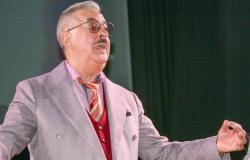He says that although endoprosthetic surgeries are long and physically demanding, this field gives him a lot of joy – there are many opportunities to constantly learn and teach, and the results of the surgery are visible as soon as the next day.
– You have been working as an orthopedic traumatologist for more than 20 years, you wrote a doctoral thesis on the topic of knee joint replacement. Why did you choose the field of endoprosthetics, even though the field of orthopedics and traumatology is very broad?
– It so happened that during the residency, I had to spend a lot of time in the operating room, assisting older colleagues in endoprosthetics of hip and knee joints. That area became close, so I don’t regret my choice one bit.
Although the operations are sometimes long and physically difficult, we can see the result the very next day. And after the healing of the postoperative wound and the completion of the rehabilitation program, the patient returns to a full life. It’s good to see a happy patient and to know that I contributed to that.
– How many patients can return to a full life after joint endoprosthesis surgery?
– Even 95 percent the results of endoprosthesis operations are excellent. This does not mean that the remaining 5 percent are bad – the result can be good or satisfactory. However, this is surgery, each case is unique and complications cannot always be avoided – a small percentage of them have always been and always will be. We talk about this with the patient and his relatives during consultations. Every time I stress that they have to trust the doctor and think about the 95%. good luck
It is not for nothing that hip surgery is said to be the second most successful surgery of the 20th century. surgery after cataract surgery is a surgery where you can get a marked effect in a short time. In the English-language literature, the term “forgotten joint” is used, which means that patients even forget that their joint has been replaced with an endoprosthesis.
– For which patients is joint replacement the most suitable treatment method?
– Endoprosthetics is a very good method of treatment already in the late stages of osteoarthritis, when other methods of treatment are ineffective. And it is always necessary to start treatment with the simplest methods that have the least side effects for the patient. When the first symptoms of osteoarthritis appear, the patient should consult a family doctor, physical medicine and rehabilitation doctor, physiotherapist. Endoprosthetic surgery is the very last stage.
We are the last in the queue, so we would like to get targeted patients who need our help for consultations. However, we often hear the frustration of patients finding it difficult to book an arthroplasty consultation when we are consulting patients diagnosed with early stages of osteoarthritis.
We often limit ourselves to recommendation-type advice on how to balance nutrition, physical activity, or we refer patients to the consultations of fellow rehabilitators, neurologists, and dieticians.
– You say that each patient’s case is unique. Are there such patients that you advise against surgery?
– Even with significant joint changes, we do not always solve the problem surgically. A patient is not a car that you can order a part for by age and model and know that it will definitely fit and that it will solve the problem. Every patient is unique. The average age of our patients is about 70 years, and most of them also have co-morbidities that can have a negative impact on the postoperative result.
Imagine a patient who “doesn’t work” in both knees and both hips, has back pain, diabetes, heart rhythm disturbances, dizziness, which often causes him to collapse – endoprosthetics of one of the joints will not significantly improve his well-being, and the risk of possible complications is enormous. In this case, we will have “beautiful” X-ray images after the operation and still an unhappy patient who will be forced to continue to seek help. A comprehensive approach is always needed.
Often patients say – “do as you did to your neighbor or relative”. However, everything is not so simple – there are no identical situations, identical patients and identical ways of solving the problem.
– We live in an age of information overload, when diseases can be “diagnosed” on the Internet, and you can talk to artificial intelligence about treatment. As a surgeon, do patients reading information online make your job easier or harder?
– My answer is both yes and no. It’s good that patients care about their health, are interested in problem solving options. This is natural. However, in medicine, as in all other fields, it is easier to form an initial opinion than to change it later. If a patient comes and says that he needs to have such an operation, use such an implant, because someone advised him, it is not easy to change his opinion, sometimes you have to put in a lot of effort.
However, the opposite also happens when the patient hears the diagnosis for the first time and learns that joint replacement surgery is recommended for him. Naturally, such news scares him, worries him. I always try to explain to patients about the possible ways to solve the problem, the pros and cons of endoprosthesis.
– Can you call joint endoprosthetic surgery a collaboration between the patient and the surgeon? What stages await the patient?
– The first and one of the most important steps for a patient is to find a doctor whom he trusts. Confidence contributes significantly to the success of treatment. In this way, it can be said that the doctor takes the patient under his care.
The patient usually spends three days in the hospital. He arrives at the hospital early in the morning, and the endoprosthetic surgery is performed on the same day. The rehabilitation phase begins the next day. Our experience shows that on the third postoperative day it is safe to discharge patients to home for outpatient treatment or to continue rehabilitation treatment in the rehabilitation department.
– Mutual trust is necessary?
– We really encounter situations when the patient does not fully trust the doctor’s recommendations, wants to hear a second or third opinion. However, the decision must still be made by the patient himself. Most of the time, they choose the opinion they prefer. And in medicine you can really hear a lot of different opinions, doctors can offer different ways of solving the problem.
Here’s one patient I operated on recently, after hearing my opinion and that of another surgeon, she opted for a smaller operation at another hospital. It’s natural, less risk, less time in the hospital.
However, the result was significantly lower and did not meet her expectations. She came back to me and asked me to solve the problem again. Therefore, as I have already mentioned, trust in the surgeon and clear communication are necessary – the treatment plan, the patient’s expectations and the expected results are discussed in detail. The patient and the surgeon must understand that they have a common goal and are on the same team.
– How does a surgeon prepare for joint replacement surgery? Do you have homework to do, or is everything so common and familiar that no extra preparation is needed?
– We prepare for each endoprosthetic operation in advance, consider its strategy, work with several computer programs, with the help of X-ray images we can simulate the operation, measure the fit and sizes of the endoprostheses. Sometimes we joke that we operate on all our patients in the evening on the computer, and the next day we repeat the same operation on the patient.
By the way, I am happy with the research opportunities available at RVUL. We can perform high-quality x-rays of various projections, perform CT and MRI examinations. I think that less than 30 percent. Western European clinics have such wide opportunities.
– You talked about improvement. Are there many changes in the arthroplasty field, or is there constant learning?
– Surgery is a changing field and it fascinates me. Surgery is changing, implants and technical tools are improving, so our opportunities are also expanding. The availability of implants is improving, and at the same time, there is progress, training, which is also an additional opportunity for surgeons to communicate with both industry representatives and doctors from other countries of the world and learn from each other.
– Is there freedom for “creation” and interpretations in surgery, or maybe in medicine in general?
– Medicine is not mathematics. Medicine is interesting in that there is no absolute truth in it – there are clear rules and algorithms, but there is also room for philosophy. These two elements go hand in hand. In many cases in medicine, several different routes can be taken to achieve a result.
– Are we in Lithuania keeping pace with the changes in endoprosthetic surgery taking place in western countries?
– I think that in many areas we are already keeping pace with our colleagues in Western Europe and the USA. And if we catch up somewhere, it can be good for us and our patients. I liked the idea of a doctor from Wales. According to him, the fact that we are a little behind is good for us, because we do not make mistakes with new implants and new technologies that are made by the first surgeons to try them. This means that we learn from the best practices and can offer our patients modern and proven, reliable treatments that lead to excellent results.






